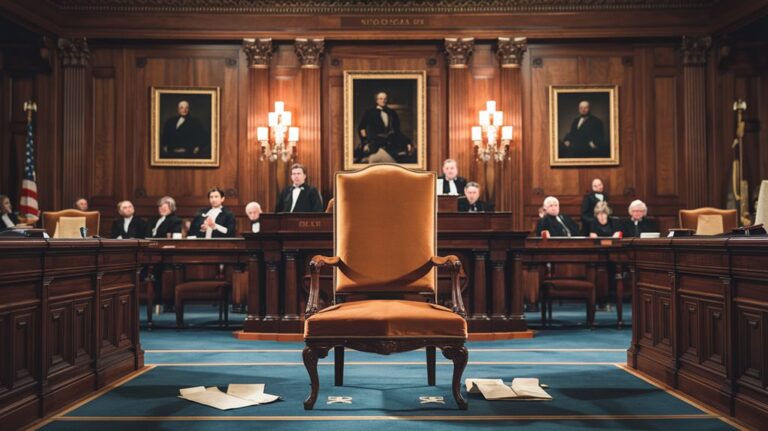The Toledo War: The Bloodless Border Dispute Between Ohio and Michigan
Much like the legendary Trojan War, but without the bloodshed or wooden horse, you'll find an equally fascinating territorial dispute right here in America's heartland. The Toledo War of the 1830s pitted Ohio against Michigan in a heated battle over a 468-square-mile strip of land along their shared border. While you won't discover epic heroes or mythical gods in this tale, you'll uncover a remarkable story of political maneuvering, militia standoffs, and a resolution that forever changed the map of the Great Lakes region.
Origins of the Border Dispute

When Congress passed the Northwest Ordinance in 1787, they unknowingly set the stage for a contentious border dispute between Ohio and Michigan. The Ordinance specified that the border would follow an east-west line drawn through Lake Michigan's southern tip to Lake Erie.
However, cartographical inaccuracies of the time placed Lake Michigan's southern bend several miles north of its actual location. After Ohio was admitted in 1803, the state aggressively defended its position on the disputed territory.
The disputed area, known as the Toledo Strip, became a focal point of tension between the two territories due to its agricultural significance and strategic location. Ohio's vision of making Toledo a major metropolitan hub connected to the Mississippi River further fueled the dispute.
The planned construction of the Miami and Erie canals only intensified the stakes, as both sides recognized the region's economic potential.
You'll find the root of the conflict in the conflicting surveys that followed: William Harris's survey favored Ohio's claim, while John A. Fulton's survey supported Michigan's position.
Key Players and Political Tensions
Three principal figures dominated the Toledo War's political landscape: Ohio Governor Robert Lucas, Michigan Territory Governor Stevens T. Mason, and President Andrew Jackson.
The key players faced mounting political tensions as both states vied for control of the valuable Toledo Strip and its essential Maumee River access. Local residents became deeply involved as Toledo citizens organized to support Ohio's jurisdiction.
You'll find that Mason and Lucas were particularly aggressive in their approach. Mason enacted the Pains and Penalties Act to criminalize Ohio's authority in the region, while Lucas secured legislative approval to deploy militia forces.
Their actions drew President Jackson into the fray, who ultimately removed Mason from his position and appointed John S. Horner in his place. The situation escalated into the only armed confrontation at the Battle of Phillips Corners.
The conflict also involved militia generals John Bell for Ohio and Joseph W. Brown for Michigan, who prepared their forces for potential confrontation.
Militia Mobilization and Armed Standoff
As tensions escalated in 1835, both Ohio and Michigan Territory mobilized their forces with substantial financial commitments.
Ohio allocated $300,000 for militia recruitment, while Michigan quickly countered with $315,000, setting the stage for armed confrontations along the disputed Toledo Strip.
The militia strategies employed by both sides led to several tense encounters. The Battle of Phillips Corners marked a significant escalation when Michigan's militia confronted Ohio surveyors.
You'll find that Michigan's aggressive approach included sending a sheriff's posse into Ohio to arrest officials and tearing down Ohio's flag.
The situation intensified when Michiganders captured nine Ohio surveyors in a field, imprisoning them in Tecumseh under the Pains and Penalties Act.
After a deputy sheriff was stabbed, Michigan's Governor Mason dispatched 200 men to Toledo, while Ohio's militia struggled through the Black Swamp en route to Perrysburg.
In a major show of force, Michigan's Governor Mason later assembled 1,000 armed Michiganders to intercept a planned Ohio court session in Toledo.
The Role of President Andrew Jackson
Despite his role as a mediator, President Andrew Jackson greatly influenced the Toledo War's outcome by siding with Ohio's territorial claims. Jackson's intervention included dismissing Michigan's territorial governor Stevens T. Mason and appointing John S. Horner in his place, demonstrating his political pressure on Michigan to accept a compromise.
The legal implications of the dispute prompted Jackson to consult Attorney General Benjamin Butler, who determined Michigan had rightful claim to the territory. However, you'll note that Jackson prioritized Ohio's political influence, with its 19 representatives and two senators. The dispute intensified when Michigan officials arrested several Ohio representatives who entered Toledo.
He sent mediators Richard Rush and Benjamin Chew Howard to propose a compromise: Michigan would receive the Upper Peninsula in exchange for the Toledo Strip. While Michigan initially rejected this deal, financial pressures and Jackson's continued influence eventually forced their acceptance at the "Frostbitten Convention."
Michigan's Path to Statehood

Michigan's journey to statehood became considerably complicated by the Toledo Strip dispute, which delayed its admission to the Union for nearly two years.
The statehood timeline was first set in motion when Michigan drafted its constitution in 1835, but Congress wouldn't approve its admission until the border conflict was resolved.
You'll find that legislative actions played a significant role in Michigan's path forward. Congress intervened by offering Michigan a compromise: give up the Toledo Strip in exchange for the western Upper Peninsula and statehood. President Andrew Jackson directly stepped in to prevent further escalation of hostilities.
Though initially resistant, Michigan ultimately accepted these terms. After relinquishing its claims to the disputed territory, Michigan officially became the 26th state on January 26, 1837, marking the end of its territorial status and the Toledo War. The Frostbitten Convention was instrumental in resolving the conflict, granting Michigan 9,000 square miles in the Upper Peninsula as compensation.
The Upper Peninsula Compromise
The Upper Peninsula Compromise emerged as Congress's solution to end the heated territorial dispute between Ohio and Michigan in 1836. Through complex political negotiations, Congress offered Michigan a deal: you'll get three-quarters of the Upper Peninsula and statehood if you give up the Toledo Strip to Ohio.
Initially, you wouldn't have found many Michigan residents excited about this trade. They didn't see much territorial value in the Upper Peninsula, and its residents actually wanted to form their own state. Under the leadership of Stevens T. Mason, Michigan's territorial governor strongly advocated for a resolution to secure statehood.
However, facing pressure from President Andrew Jackson and a looming financial crisis, Michigan's second convention accepted the compromise in October 1836. It's a decision that proved remarkably fortunate – the Upper Peninsula's rich deposits of copper and vast lumber resources later became vital to Michigan's economy.










